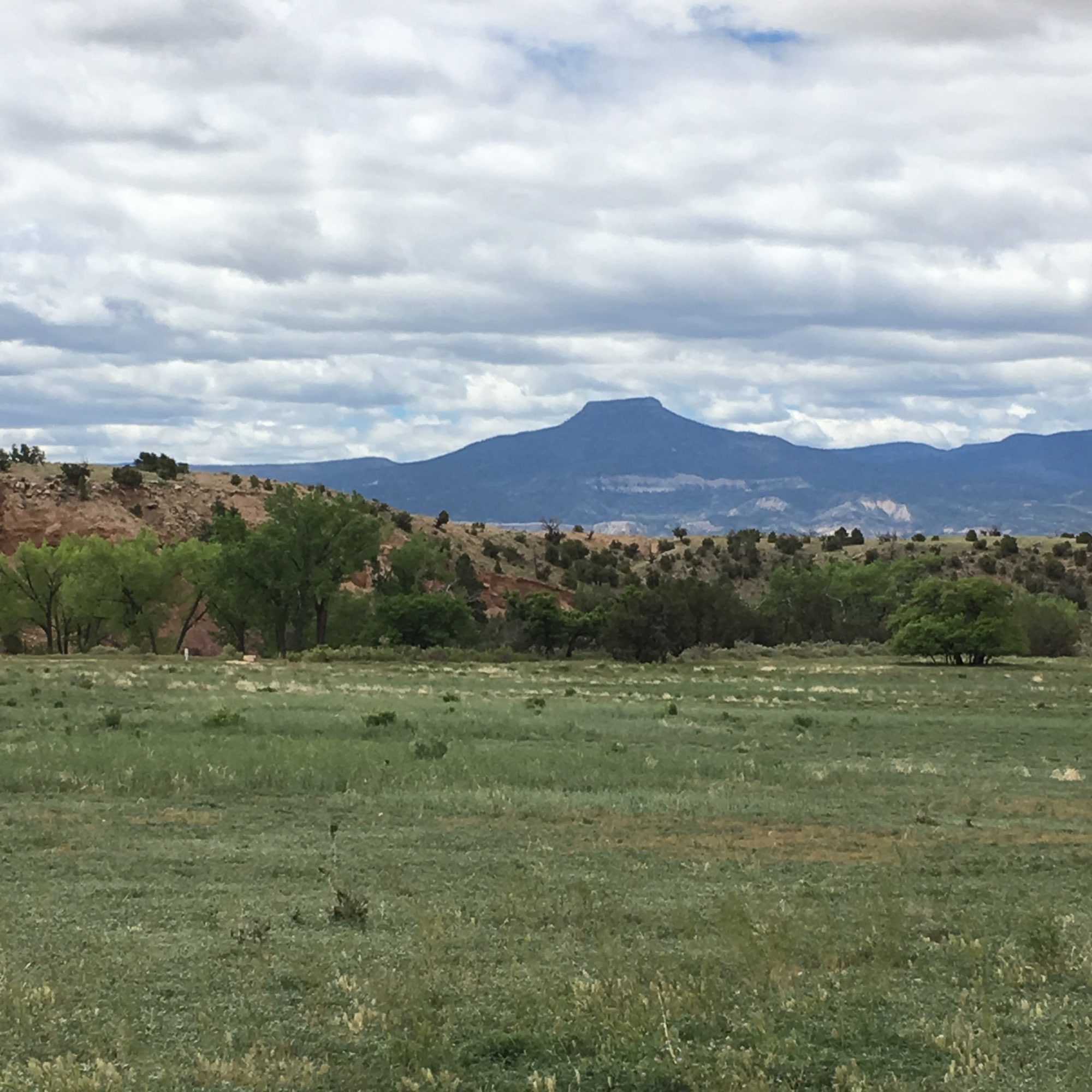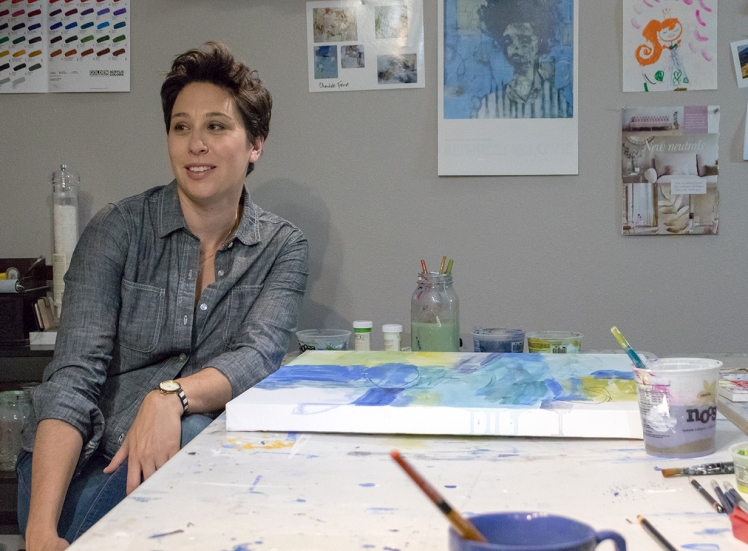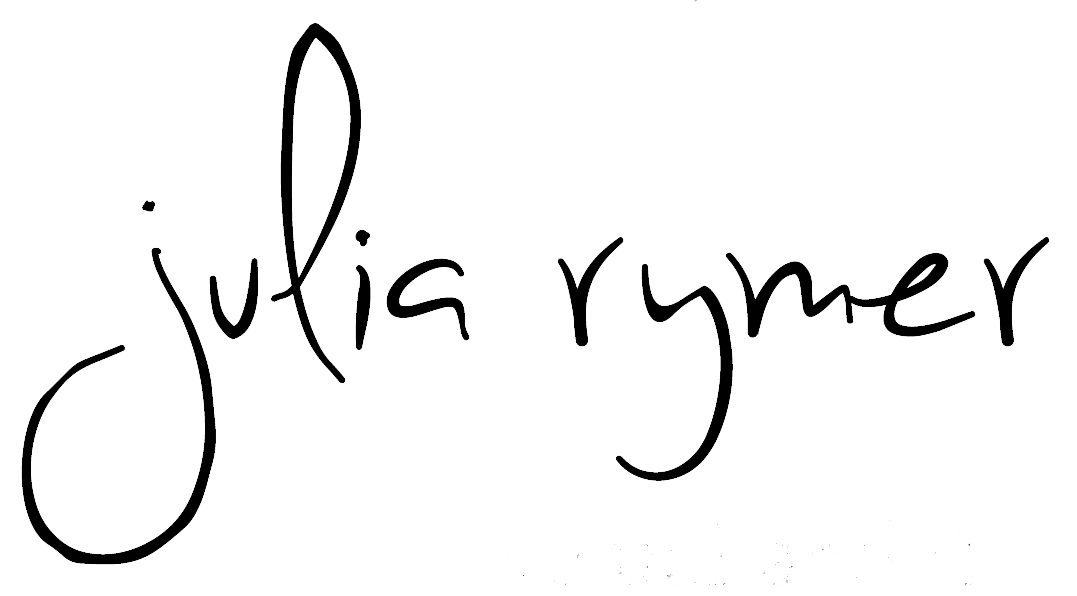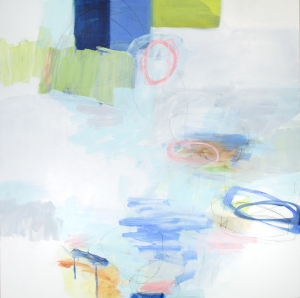
A personal essay exploring the intersection of art, science and the transcendent experience.
by Julia Rymer
When I look at the sky, I feel as if I live in it. It is a subsuming force, one I observe constantly throughout the day. I am caught in the interactions of cloud and color and light: all glistening and silver; or dark, inky blue; or soft and gray; or infused with pink and gold; or with silhouetted trees and mountains.
Nature is a place of transcendence for me, even in small moments or in passing.
I spent my childhood immersed in nature. I grew up playing in the plains and mountains of Colorado, encountering big mountains and big skies. I skied, hiked, wandered, camped. My parents were wannabe ski bums, mountain people. As an adult, I chase that feeling from my childhood, of being one with nature – and being of it, intertwined, connected.
Abstract painting is how I respond to nature, and my experience within it. With color, mark, and form, I bear witness to my place in the natural world, and honor its mystery.
At the tail end of graduate school in New York, I wandered into a bookstore and found A Sense of the Mysterious, by theoretical physicist and writer Alan Lightman. I took this book home to my lonely apartment in Park Slope in Brooklyn, and promptly devoured it, finding in it a familiar language for my experience as an artist and nature-lover.
Lightman’s writing illuminates the profound relationship between humans and the natural world. He captures our human wonder and awe at the phenomena and structure of nature, which we discover through scientific inquiry and research. The scientific method and resulting theories are not so much immutable facts as they are a means by which we understand our physical environment and the patterns and messages it holds– much in the way that art is a means to express and understand life and that same natural phenomena. Lightman asks us to notice the magic of scientific discoveries, pondering their meaning and implication for our society as well as our selves. And he asks that we remain fully human, awake to the mystery of this planet we live on, and the workings of our universe.
Science is not about expression, though. For us to explore the emotional, transcendent experience of nature—and perhaps we can be brave and call it the spiritual experience– we need something else.
We need art.
It was Lightman that helped me find the thread that connects art and science. He unites these seemingly disparate modes of thought, offering them as a continuum, each a method for interpretation and discovery, both personally and universally.
In “Words,” an essay from A Sense of the Mysterious, Lightman observes:
“One important distinction that can be made between physicists and novelists, and between the scientific and artistic communities in general, is in what I shall call ‘naming.’ Roughly speaking, the scientist tries to name things and the artist tries to avoid naming things.”
Lightman connects the emotional resonance of the physical world with the concrete ideas behind it. Essentially, a scientist works to name things—to quantify them, pin them down—in order to understand the thing as a mechanism or a function. On the other hand, artists are not working to pin any thing down, but rather to unveil the meaning of the thing.
With the artist’s touch, the thing envelops into metaphor, an experience, a feeling. It moves beyond its name.
But, we can be both scientist and artist. We can exist with names, and beyond them. We can understand our world, and transcend it.
Art is about experience, and science is about definition. The two appear to contrast—one nebulous, the other concrete—but at their core, they are exploratory. The act of discovery can be accomplished through painting or in the laboratory, through dance or through math.
Recent studies of Neanderthals suggest that they were, in fact, artists—and much smarter than we originally thought. This realization also says to me that art is not necessarily the purview of the intellectual, but rather is a primal imperative, rooted in us as creatures. We make marks and draw the shapes of what we see not just to describe what we have seen, but also to say how we feel about what we have seen. In essence, we create to make ourselves seen.
I paint abstractly because no literal representation could capture what I feel. My work goes beyond naming, and the use of images and words. Instead I develop my own language, fundamental in its use of mark and form, as a personal, emotional alphabet. I go beyond the constructs of what is seen in the natural world, and delve into what I feel.
The thing I am trying to quantify and explore in my work is the transcendent experience. That feeling in which I am very small, and the world is very big; in which beauty and power are all-encompassing. The sky, a mountain, the tree as it changes color with the season.
Nature is a place of transcendence. Nature brings us in connection with the divine, the sublime, with ourselves, with our mortality, with eternity. We ask questions of it, and it asks questions of us. Nature reflects our humanity back to us, as we project our humanity onto it.
In his book Searching for Stars on an Island in Maine, Lightman dives into the contradictory spaces of science and spirituality, seeking to reconcile their conflicts. He ponders the two, drawing Venn diagrams of scientific and spiritual thought. Nature is where he finds the connection.
In my view, spirituality has long been the purview of the artist, who, working as shaman or mystic, unveils the magic of the physical world – in other words, elucidating the concept of transcendence.
We, as humans, have a need to understand our world and our universe. And to fulfill this need, we require multiple modes of discovery and exploration: science, art and spirituality. Science elucidates the functioning of our physical world; art and spirituality unveil its meaning.
Lightman remarks:
“Regardless of which belief you subscribe to, the transcendent experience, unlike the received wisdom acquired from the sacred books, is intensely personal. And the authority of that experience and the understandings gained from it rest in the experience itself. No other person can deny the validity of what you have felt. The feelings cannot be disproved. The transcendent experience as an avenue to truth is a deeply human path.”
The transcendent experience is a singular data point, but it does not need a proof. The experience is the proof.
This is one of the reasons that I am an artist. I need to create and discover, in my own way, my relationship to nature – to explore the meaning of nature, and who I am in response to it.

I am no scientist, nor have I ever been one. But I am, no less, on a path of discovery, of exploration, as different as it may look from a scientist’s passage through their research. My lab is a studio; my instruments are color and brush and pigment and fabric and paper. I take these tools and make of them something else entirely, moving beyond naming, crafting a vision, a manifestation, of this lived human experience in a world shaped by time and tumult – and I do so to leave a mark like the ancients in their caves that came before me.
Sources:
Alan Lightman, A Sense of the Mysterious. New York: Pantheon Books. 2005.
Alan Lightman, Searching for Stars on an Island in Maine. New York: Pantheon Books. 2018.
Emma Marris, “Neanderthal artists made oldest-known cave paintings,” Nature, https://www.nature.com/articles/d41586-018-02357-8, February 22, 2018.


Recent Comments